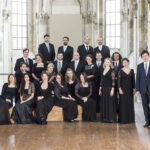| 22. 12. 2023 19:00 p.m. |
| Kino Vesmír |
| from 400 CZK |
M2 Christmas Concert
The Czech Christmas Mass, one of Mozart’s most beautiful compositions, and Zelenka’s solemn composition, which also impressed his better-known contemporary JS Bach, will be on the program of the Christmas concert. The Janáček Philharmonic will be led by conductor Václav Luks and accompanied by his ensemble Collegium Vocale 1704.
Jan Dismas Zelenka
Magnificat in D major ZWV 108
Wolfgang Amadeus Mozart
Exsultate, jubilate KV 165
Jakub Jan Ryba
Czech Christmas Mass “Hey master!”
Slávka Zámečníková – soprano
Václava Krejčí Housková – alto
Václav Čížek – tenor
Roman Hoza – bass
Collegium Vocale 1704
Janáček Philharmonic Ostrava
Václav Luks – conductor
The concert will feature Christmas-themed compositions of Central European Baroque and Classical music. The Janáček Philharmonic Orchestra will be accompanied by conductor Václav Luks and his ensemble Collegium Vocale 1704, which specialises in the authentic interpretation of early music.
The Czech Baroque composer Jan Dismas Zelenka spent most of his life in Dresden, where he worked as a violinist and court composer for the Saxon Elector and king of Poland, Augustus II. Most of Zelenka’s compositions are sacred works. The solemn composition Magnificat in D major caught the attention of even Zelenka’s more famous contemporary Johann Sebastian Bach.
Exsultate Jubilate is one of Mozart’s most beautiful and popular compositions. The virtuosic soprano part, which in the final Alleluia is bursting with coloratura, was written by the sixteen-year-old Mozart for countertenor Venanzio Rauzzini. This time, however, it will be taken by Slovak soprano and soloist of the Vienna State Opera, Slávka Zámečníková.
Czech Christmas Mass “Hey Master!” by Jakub Jan Ryba has been a symbol of Czech Christmas since the 19th century. Ryba composed this work in 1796 for the church choir in Rožmital pod Třemšín, from where it quickly spread throughout Bohemia and Moravia. Its distinctively melodic music with folkloric motifs and charming, folk-naive text about the birth of Christ has ensured the work’s enduring popularity to this day.







